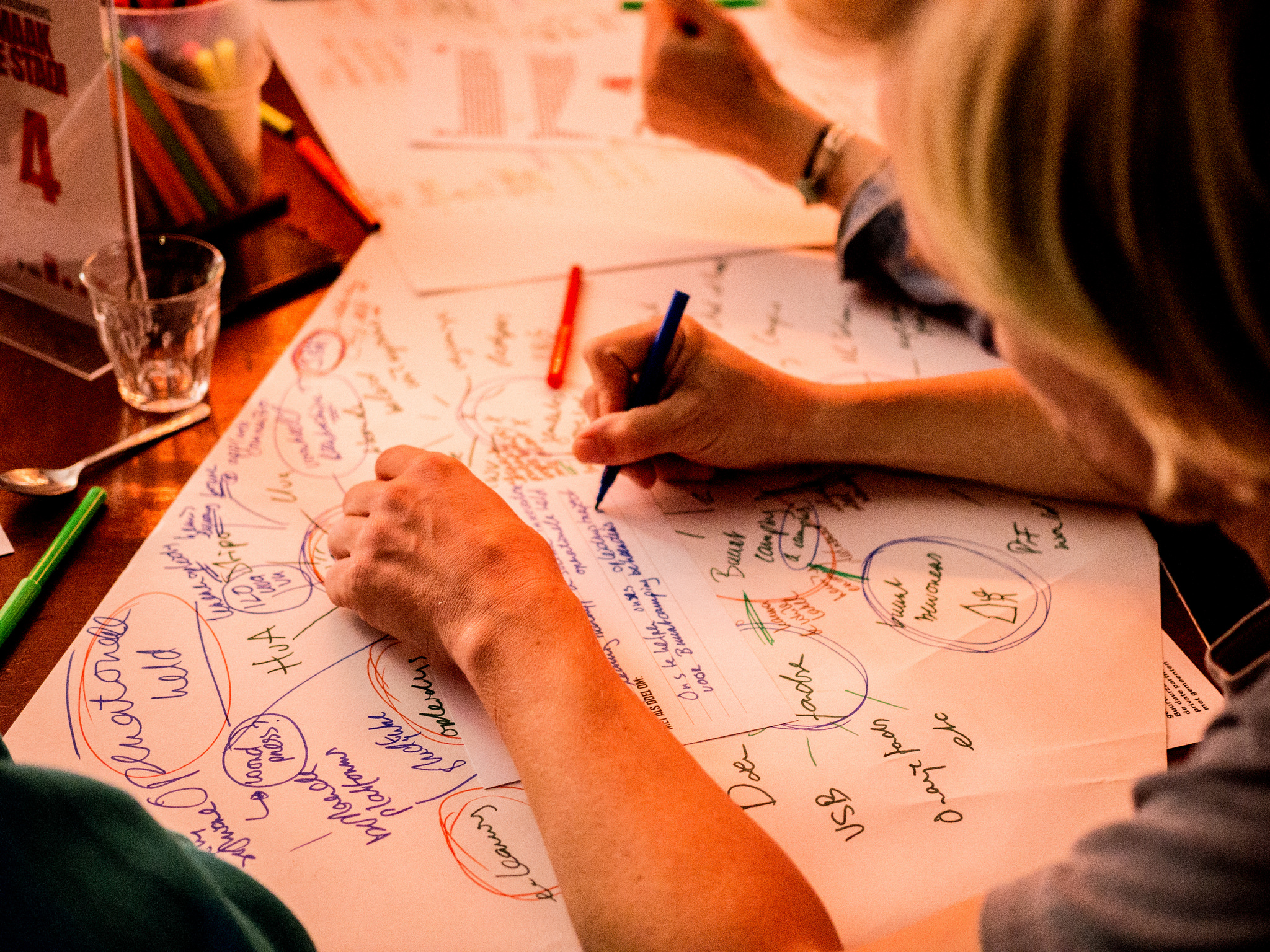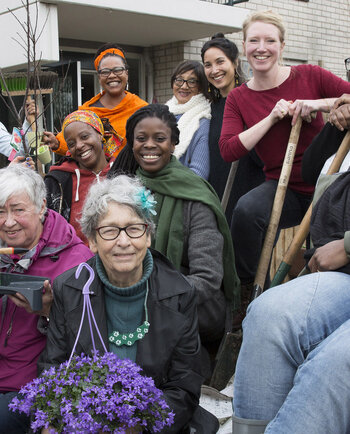
Forget about impact: let’s be honest about systems change
Tessa de Geus Adviseur sociale en stedelijke innovatieThe obsession with mapping social impact distracts us from the discussion that we should be having: that social innovation does not evidently equate systems change. We need to urgently invest in a comprehensive understanding of systems if we want to forge social change.
The social innovation++Social innovationHere I use the definition coined by the TRANSIT programme: a process of introducing new social relations, involving the spread of new knowledge and new practices (in which ‘new’ is a matter of degree and perspective’). movement has been gaining traction around Europe for over a decade. But the obsession with mapping social impact distracts us from the discussion that we should be having: that social innovation does not evidently equate systems change. Social innovation movements need to urgently invest in a comprehensive understanding of systems if we want to forge social change.
During the social innovation conferences I have attended lately, the key discussion can be neatly summarised along the lines of ‘How do we fund or scale up social innovation initiatives?’, ‘How do we collaborate across sectors to create an ecosystem of innovation?’ and, inevitably, ‘How do we measure social impact?’. I kept wondering to myself: before we talk about impact investment or logframes++Impact investment or logframesThe Global Impact Investing Network (GIIN) defines impact investments as “Investments made into companies, organizations, and funds with the intention to generate social and environmental impact alongside a financial return.”
A log frame (logical framework) is a method used to take what ultimate impact you want to achieve and work down to how your activities contribute to that.
, why don’t we elaborately address the root causes of the social issue(s) we work on? – The values, power relations, flows of information, institutions and political dilemmas we identify, and the vision we want to work towards. If we muzzle ourselves and refrain from answering these questions, social innovation attempts will forever remain in the margin, obscuring the excesses of dysfunctional systems.
Kick the system out of the room
If we want to improve our understanding of full-stack systems, we need to first invest in an understanding of what a system is comprised of. In the social innovation field, there is hardly a common understanding of the term system. In the Netherlands for instance, the difference between the system (“systeemwereld”) and people’s lived experiences of social issues (“leefwereld”) is often conflated with describing discrepancies between bureaucracy, bureaucratic culture and the lived reality. Another interesting use of the word is in the phrase “getting the whole system in the room”, which seems to refer to having representatives of all key stakeholder groups present during work sessions, aiming to generate perspectives on problems and solutions from across disciplines (or ‘silos’ as they are called in the bureaucratic lingo).
TIf we want to improve our understanding of full-stack systems, we need to first invest in an understanding of what a system is comprised of.he famous systems scholar Donella Meadows proposes a rigorous definition. She considers a system to be:++Donella MeadowsDonella Meadows was an American environmental scientist, who is best known as lead author of the The Limits to Growth. This quote comes from the book Thinking in Systems (2008).
“an interconnected set of elements that is coherently organized in a way that achieves something A system must consist of three kinds of things: elements, interconnections and a function or purpose”.
Examples of systems are corporations, an economy, a city, or your body. This definition invites us to develop a sophisticated analysis of societal problems, in which a system is more than either bureaucracy or a boardroom filled with direct stakeholders. If anything, this understanding is not definitive, but an invitation to come to your own definition.
Systems as we encounter them in social innovation start with values and belief systems – so for instance, neoliberalism. We formalise these values in legislation, build institutions around them and agree on decision-making processes and instruments (such as accounting structures, taxes or police) to maintain them. Ultimately, compliance to the system is also an intrinsic element; should everyone choose to disobey a system, it disintegrates.
In order not to become overwhelmed by this definition, Odin Mühlenbein from Ashoka distinguishes two levels of systems in his article Systems Change Big or Small. He identifies “big visions”, which can be broken down in smaller “targeted systems”. For instance, he refers to a targeted system in the garment industry, in which a network of fashion brands committed to using eco-friendly viscose, Canopy, matches viscose producers and technology providers for sustainable production.
Lose the logframe?
Today, many social programmes++Social programmesWith social programmes I’m referring to either citizen-based social programmes (examples can be found through Maak je Stad!), government-based, or corporate-based social initiatives. can indeed be praised for providing great social services or products. They can be of vital importance for a healthy democracy, social cohesion, and can make a positive difference for individuals’ lives. Not allNot all city makers are systems changers – and that’s ok. social initiatives, or city makers++City makersBy city makers I mean citizens who take responsibility to address social and environmental issues in their city through a tangible initiative. This can include students, social entrepreneurs, artists, neighbourhood communities, etc., are systems changers – and that’s ok. But in some cases, this truly makes for a missed opportunity: without a common understanding of systems failure, the hard work of individuals will not provide input for fundamental changes that are needed in a field. It’s therefore crucial to know whether you are addressing a root cause or mere symptom with your intervention or idea, and how your initiative is embedded in the wider frame.

Participants of Amsterdammers, Make your City! during a session on partnerships.
Many social innovation initiatives work with logical frameworks (logframes) to define and measure their social impact. This allows them to steer towards desired outcomes, be held accountable, and attract new funders by offering proof for their hypothesis. Indeed, to prevent unwanted outcomes, it’s crucial to monitor the effects of social interventions++Effects of social interventionsSocial programmes can also produce negative social impact. For instance, it was found that a famous buddy programme started in the Great Depression actually caused participants to do worse than their peers in the control group. Listen to the full story on the podcast “When Helping hurts” by Freakonomics. and test underlying assumptions when providing a service or product. Measuring impact can be important, but without an idea of targeted systems and big visions, such ‘impact’ remains powerless. Besides, the obsession to optimise social impact can lead to situations in which initiatives undermine their own value by monetising their supposed societal benefit and disconnect from the bigger picture.
An example: The latest impact assessment of the Dutch Thuisafgehaald++ThuisafgehaaldHere you can read the full impact report conducted by Thuisafgehaald and Avance. , a social enterprise that allows neighbours to cook for and share meals with each other, suggests that their service saves up to € 4446 euros per person a year for reasons like preventing loneliness and extending the time people can stay in their own apartment instead of moving to a care home. It’s understandable that Thuisafgehaald uses these metrics to convince potential funders, and to assess whether their service satisfies their customers. However, apart from the metrics being somewhat questionable in this case, Thuisafgehaald’s value is much better understood when they position themselves as part of a movement, redefining the foundations of what it means to deliver good care.Apart from the metrics being somewhat questionable in this case, Thuisafgehaald’s value is much better understood when they position themselves as part of a movement, redefining the foundations of what it means to deliver good care. Consequently, it needs to be understood what the implications could be for care institutions or managing the social fabric in neighbourhoods.
Seeing systems
For the Kennisland project Amsterdammers, Make your City!++Amsterdammers, Make your City!Amsterdammers, Make your City! was designed and implemented by a consortium of the City of Amsterdam, Kennisland, Pakhuis de Zwijger, Waag, Amsterdam Economic Board, Amsterdam Smart City and AMS. , I made sure that the 36 city makers in our accelerator programme completed a logframe during the first session. Looking back, we should have instead invited these city makers to develop a “big vision” and consequent “targeted system” in which they operate, including the values, institutions, and relations they eventually aim to change. Preferably, this should happen together with other players, like civil servants. To unlock the creativity of citizens, civil servants and entrepreneurs to create sustainable change, we need to make rigorous analyses actionable and collaborative, instead of hailing one-off optimistic initiatives as the silver bullet.++Actionable analysisAn interesting example of that can be found in the approach employed by What Design Can Do. They provide briefing packages to break down systems around complicated issues such as climate change.
City makers or social entrepreneurs do not need to obtain a PhD in systems change. Understandably, they are often focussed on delivering their service or product. But social enterprises and social labs alone are not going to change systems. There lies an opportunity for organisations like Kennisland to fuel this debate and collect research evidence to inform it. In fact, if civil society does not address this issue, we might even cause harm by prompting unrealistic expectations for the effect of citizen-based initiatives and inclusive – for lack of a better word – ‘bottom-up’ processes.
We can use systems change literature to deepen this discussion about what could be the right ‘leverage points’++Leverage pointsRead more about this concept described by Donella Meadows in the article “Leverage points: places to intervene in a system“. to act on: “places within a cTo unlock the creativity of citizens, civil servants and entrepreneurs to create sustainable change, we need to make rigorous analyses actionable. omplex system where a small shift in one thing can produce big changes in everything”. Donella Meadows identifies twelve of such leverage points, from tinkering with subsidies and taxes to changing mindsets of whole populations. This analysis provides us with rich input that should be used to develop tools for social innovation initiatives (or perhaps they already exist?++Tools for social initiativesIf you happen to know about any, let me know!). These frameworks can be used to build a common agenda around social issues, and to build ‘collective impact coalitions’++Collective impact coalitionsRead more about collective impact coalitions as studied by John Kania & Mark Kramer in this article on the Stanford Social Innovation Review. . That’s when the above mentioned ‘innovation ecosystems’ could truly become relevant and effective.
Importantly, all of the above has great implications for the way funders work. Rather than holding one single initiative accountable for producing so and so impact, funders need to set up stable collaborations with governments, private sector companies, non-profits, philanthropists and social change leaders around specific issues. The new Rockefeller fund Co-impact is spearheading such new ways of collaborating across sectors to forge systems change. If we want to move the needle through social innovation, this lever needs to be addressed and funding strategies need to change across the sector.
Stepping up our systems game
What is considered in or out of system ultimately is an issue of power: systems analyses are not a neutral exercise. Conflicting views will inevitably arise. But we have the responsibility to continuously strive for an open discussion about it, rather than claiming to have a ‘whole system in the room’. Again, civil society organisations have an important task to expose such power dynamics and demand for other views and evidence to be included. It also means that we have to come to terms with the fact that systems change does not happen overnight, but over the span of lifetimes.
The social innovation movement is due to have its coming of age.The social innovation movement is due to have its coming of age. The implicit notions of the socially just, sustainable societies that we aim for need to be made explicit, more sophisticated and political. To be truly accountable for the work that we do, we need to quit our obsession with impact evaluations and step up our systems game.
If you’re keen on continuing this conversation with me, do get in touch: tg@kl.nl


